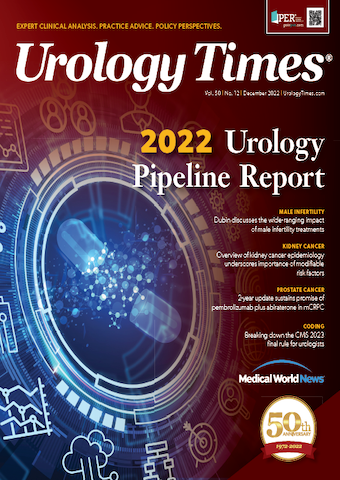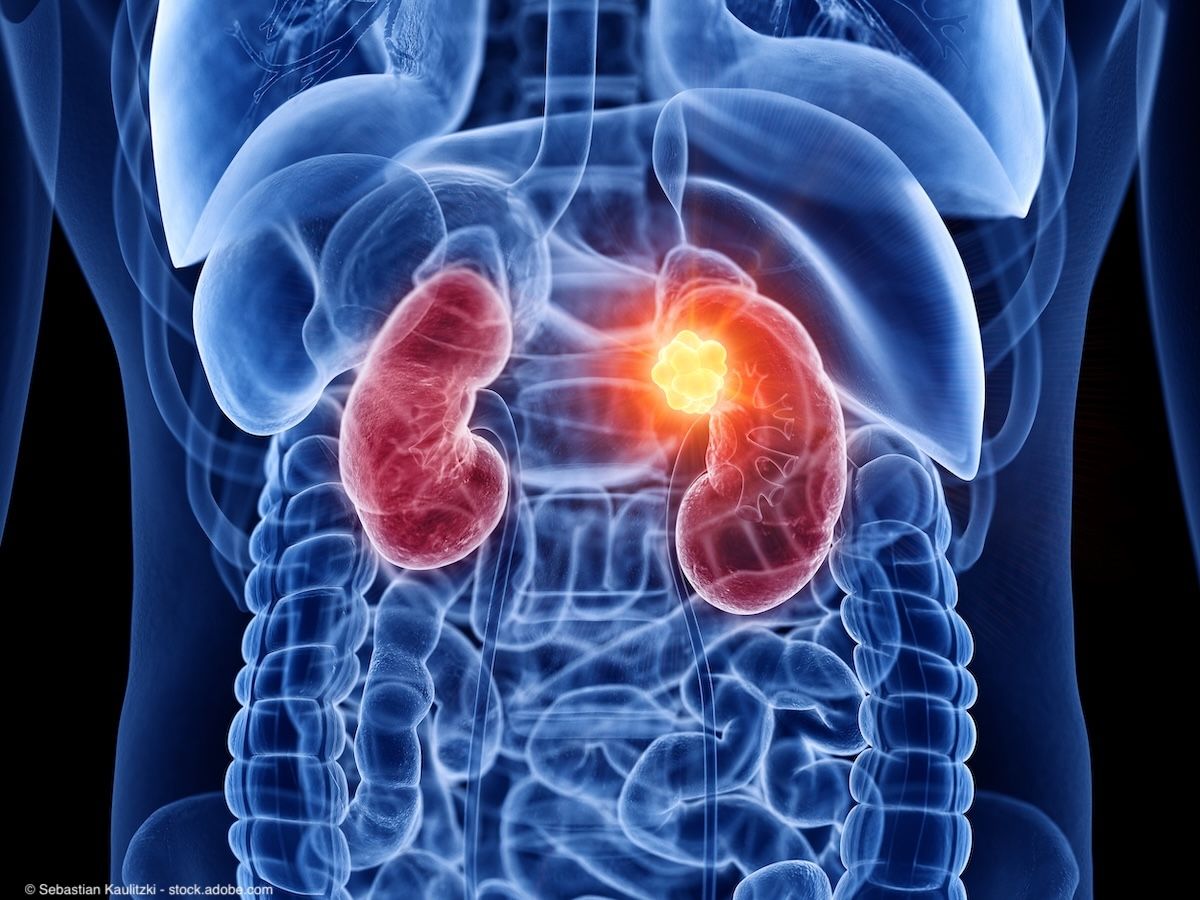Publication
Article
Urology Times Journal
Overview of kidney cancer epidemiology underscores importance of modifiable risk factors
Author(s):
"What was surprising to me is that the incidence [of kidney cancer] has leveled off over the past 2 years," says Laura Bukavina, MD, MPH.
Laura Bukavina, MD, MPH, asks, "Has [kidney cancer] mortality rate dropped off because our incidence has been climbing so high for these incidental, small tumors and mortality is not going to be high in those small renal masses? Or is mortality improving because our therapy is getting better?"

In this interview, Laura Bukavina, MD, MPH; and Sarah P. Psutka, MD, MS, discuss “Epidemiology of Renal Cell Carcinoma: 2022 Update,” which was recently published in European Urology.1 Bukavina is a urologic oncology fellow at Fox Chase Cancer Center in Philadelphia, Pennsylvania. Psutka is an assistant professor of urology at University of Washington School of
"It’s important that we continually reassess the epidemiology and the risk factors for these disease processes," says Sarah P. Psutka, MD, MS.

Medicine and a physician at Fred Hutch Cancer Center in Seattle.
Can you discuss the background and rationale behind this paper?
Bukavina: Every couple of years, there is a paper about epidemiological risk factors of kidney cancer incidence and mortality, because we know that there are a lot of things that are changing in the world, including risk factors and identification of potential risk factors. So every few years, there’s an update with any new information that…is relevant for any urologist or researcher within kidney cancer.
Psutka: Dr Bukavina brings up a really important point, which is that as urologists and scientists we think about epidemiology and these basic risk factors as being somewhat static. But actually, there has been a tremendous amount of work and understanding around environmental exposures that we didn’t even know existed 10 to 15 years ago, which was where a lot of the statistics that I traditionally quoted in patient interviews came from. It’s important that we continually reassess the epidemiology and the risk factors for these disease processes. This paper really highlights our greater understanding of the genetic and genomic backgrounds and risk factors, how those interact with the environment and patients’ own personalized risk factors. Getting to the nuances of that is critical, which is what these updates provide us with an opportunity to highlight.
Bukavina: Going back 10, 15, 20 years ago, before we had some of the technology that we have available now, clinicians used to think of risk factors as lifestyle risk factors. Now we know that these risk factors are not just lifestyle risk factors, but—whether it’s mutagenic, tumorigenic, or carcinogenic potential in these risk factors—it’s your exposure. Some of these risk factors are hereditary, but a lot of the things that we see in kidney cancer are exposures that you can control, and now we’re getting deeper into the mechanisms. That’s important because you might think of this as an isolated kidney cancer picture, but exposure is exposure, right? Exposure doesn’t predispose you just to kidney cancer. Once we find something that’s potentially relevant to kidney cancer, can we use that information and look at other cancers such as bladder cancer or any genitourinary cancer? Maybe this is a carcinogen that goes well outside the genitourinary space.
What were some of the key points and findings that came out of this paper? Were any a surprise to you?
Bukavina: We have all known that the incidence of renal cell carcinoma—which is the number of cases reported per year per 100,000 individuals—has been steadily increasing. That’s been reported in the literature. It’s nothing new. What was surprising to me is that the incidence has leveled off over the past 2 years. That’s probably because clinicians are realizing not everyone needs a CT scan for every small abdominal pain or hiccup.
Also, the mortality rate has dropped off. There are 2 schools of thought here. Has mortality rate dropped off because our incidence has been climbing so high for these incidental, small tumors and mortality is not going to be high in those small renal masses? Or is mortality improving because our therapy is getting better? Are we just improving the outcomes in patients with better therapy? Right now, it’s a bit difficult to say. There’s a certain lag in time before these therapies were instituted to what we’re looking at now, so it’s difficult to say.
The second thing I found reassuring is that we see a lot of disparities in care and survival in minorities and women, especially Black patients, and we didn’t see that in kidney cancer. Black patients have almost identical mortality as White patients, even though they have a higher incidence of kidney cancer diagnosis.
Psutka: One factor that has become apparent to me and that we really tried to highlight in this paper…is the component or the risk that comes with kidney disease with end-stage renal failure and transplant. There’s increasing understanding of how the immunosuppression that comes with undergoing an organ transplant increases the risk for cancer. That has been previously stated, but it wasn’t strongly acknowledged in the urologic literature.
Also, the association between CKD [chronic kidney disease] and end-stage renal failure and increasing risk of kidney cancer is a striking and important association to be aware of. It’s something that I’m seeing in practice, but it’s a trend that hasn’t been strongly acknowledged in our literature. That was something that I found interesting, and it heightens the awareness, given the increasing prevalence of end-stage renal failure and kidney cancer and CKD globally.
What questions arise out of what you discovered?
Bukavina: The biggest question that arose from this is, “Why is there such a lack of large familial genetic disorder epidemiological studies?” There are only 7 or 8 hereditary familial disorders that we’re basing all of our knowledge on. A lot of these, when you look at the studies, were assessed in 1000 individuals here, 500 individuals there, but there’s not a huge population study looking at these familial risk factors. I’m wondering why no one has looked at this with huge databases, such as UK Biobank and TCGA [The Cancer Genome Atlas]. It’s curious that no one has probed to see what the actual incidences of these familial syndromes are, especially if you have a huge, healthy cohort to go along with it.
Psutka: I think that’s incredibly important. In TCGA alone, we identified that somewhere between 6% and 9% of kidney cancer cases appear to have a germline alteration. That’s relatively low. It begs for us to understand more about the genetic underpinnings and their interactions with these environmental exposures and lifestyle risk factors that predispose high sporadic rates of kidney cancer.
There are still a lot of unknowns, such as why is there variability in the age presentation? Why is the average age at diagnosis younger in the United States compared with other developed countries? Granted, there’s certainly going to be the confounding based on the ubiquity of cross-sectional imaging and whether it’s a lead-time bias and we’re just catching them earlier.
There is also substantial variation in these environmental exposures. One of the things we tried to highlight was that although there are germline variants and more well-acknowledged genetic syndromes that include kidney cancer, there’s an increasing number of other variants of kidney cancer that have been identified. If you look at the new [World Health Organization] classification for kidney cancer, there are all of these new histologic variants that we previously did not identify within the greater context of kidney cancer. We are starting to get to the genomic underpinnings of those diseases and understanding the mutations that are different among them. Are we misclassifying some of these tumors? Are we missing them?
I think that as we get better at molecularly understanding and classifying these diseases, we’ll probably get a better understanding of the genetic risks. Then we can get to the nuances of the interaction between those genetic risks and the environmental risks. The holy grail here is—and this is potentially a dangerous comment—when do we start the risk-adapted screening? All the patients that I see come in and say, “Why didn’t we look for this? Why did I only find this because I went in with gallbladder pain?” The truth is, at some point, we may have enough of an understanding to be able to thoughtfully employ a program such as this. We’re far off from that right now.
Overscreening, of course, would be a disservice. Lack of appropriate utilization of active surveillance is something we need to continue to work on because we don’t want to overtreat patients with kidney cancer. Identifying those patients who present with these very large tumors before they come in because of symptoms—if we could figure out ways to start to catch these patients earlier, that’s the holy grail. Hopefully, as we start to understand these genetic nuances, we can get closer to that. That’s what these epidemiological surveys—and to Dr Bukavina’s point, larger, thoughtful genetic surveillance studies—can potentially do to move the needle here and drop mortality rates even lower.
Bukavina: Unfortunately, I think a lot of patients have heard about these blood screening tests for all kinds of cancers, but they really don’t come close. They use platelet RNAs and ctDNAs. For kidney cancer, especially, [the sensitivity is] notoriously terrible, less than 40%. That’s even at stage IV. So these are not good tests for screening of any population, let alone patients who have hereditary disorders. We’re very far away from it, but we’re slowly making our way.
What would you say is the take-home message for the practicing urologist?
Bukavina: We need to continue to push the field forward, and the way we do that is to evaluate the risk factors and to stratify patients based on their risk factors and their genetic components. Not every kidney cancer is the same. As we continue to learn about them, every urologist needs to continue to learn with us. We need to be open to the idea that we might have to change our practice, not just based on a patient’s history but also their molecular underpinnings.
Psutka: That’s a critical point that Dr Bukavina makes. The other thing that I would say is a take-home message is that there are so many modifiable lifestyle risk factors for kidney cancer that even if we modify them in the context of a diagnosis, we can improve outcomes. Smoking cessation is still a critical modifiable risk factor. If we stop the patient with kidney cancer from smoking at the time of diagnosis, we can improve outcomes for that patient. Similarly, obesity, visceral adiposity, and exercise are key modifiable factors. Patients come to us and we tell them about things such as surgical treatments that we can offer them, immunotherapies, targeted agents, but there are many things that they can work on. They can reclaim some agency in this whole process and control outcomes.
Understanding epidemiologically the impact of things such as obesity, smoking, and hypertension—those are all factors that are very useful to be aware of in our clinical practice. Hopefully, there’s a little something in this paper for everyone. Dr Bukavina did a beautiful job of describing the most up-to-date genetic and genomic understanding of the background of this disease. We also tried to be thoughtful about putting out what’s known about these modifiable risk factors, which is eminently important when you’re counseling a patient before a nephrectomy.
Bukavina: I anticipate in the next update, which will happen in a couple of years, there are going to be even more things discovered about microbiome and risk factors. The microbiome is a very modifiable factor and potentially so are exposures in the environment, such as microplastics. There are several projects underway and the next update will definitely have more of these available.
Is there anything else you would like to add about the paper?
Bukavina: It’s a huge team effort. The physicians on this manuscript are experts in their field and it was an honor to be part of it. I hope everyone can learn something from it.
Psutka: We’re very fortunate to be in a field where there’s a lot of development in the past couple of years, largely due to the incredible contribution of many of the authors on this paper. It was an absolute honor and a privilege to get to work with Dr Bukavina and the remainder of the team, who all contributed their own expertise in important ways to advance our understanding of the epidemiology of kidney cancer.
Reference
1. Bukavina L, Bensalah K, Bray F, et al. Epidemiology of renal cell carcinoma: 2022 update. Eur Urol. 2022;82(5):529-542. doi:10.1016/j.eururo.2022.08.019

Newsletter
Stay current with the latest urology news and practice-changing insights — sign up now for the essential updates every urologist needs.
























